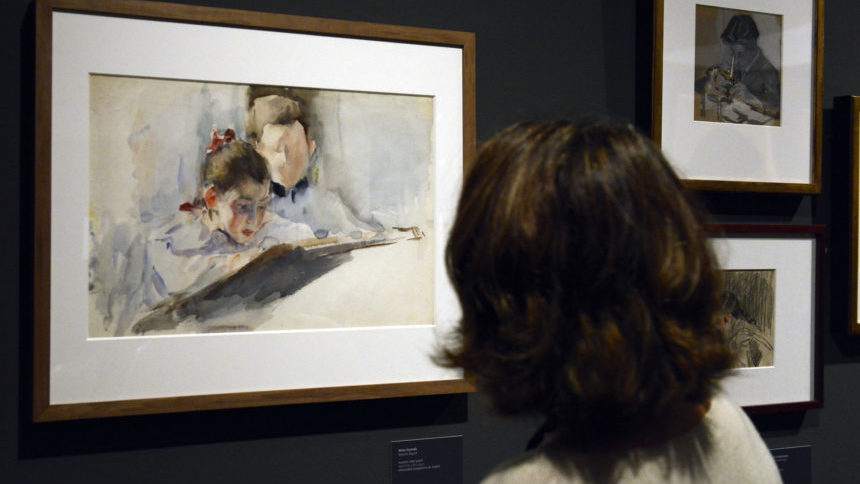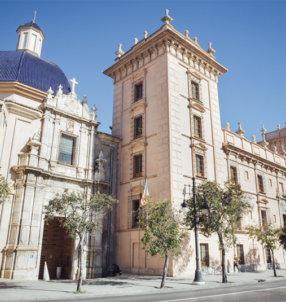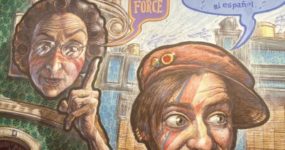##The exhibition offers for the first time in Valencia a selection of a hundred drawings by Joaquín Sorolla, a little known facet of the Valencian artist, but which he practised intensively throughout his artistic career.
Fundación Bancaja has presented the exhibition ‘Sorolla. Dibujante sin descanso’, produced together with the Museo Sorolla and the Fundación Museo Sorolla, which offers for the first time in València a journey through the production of drawings by the Valencian artist that can be visited until 9 January 2022. The presentation was attended by the president of the Bancaja Foundation, Rafael Alcón; the director of the Sorolla Museum, Enrique Varela; and the curators of the exhibition, Inés Abril and Mónica Rodríguez Subirana, as well as the great-granddaughter of the painter and patron of the Bancaja Foundation, Blanca Pons-Sorolla, and the president of the Standing Committee of the Sorolla Museum Foundation, Antonio Mollá.
The exhibition shows more than one hundred drawings by Joaquín Sorolla, all of them from the collection of the Sorolla Museum with the exception of one from the collection of the Bancaja Foundation, three on loan from the Complutense University of Madrid and one from a private collection, being exhibited to the public for the first time. The selection allows us to perceive the evolution of the artist’s brushstrokes and reveals the aspects that most concerned him in the practice of art. The collection also reveals the different uses the painter made of drawing. Sorolla not only used the graphic medium as a preliminary to his pictorial work, as a means of preparation and exploration for his large canvases. He also used drawing as an end in itself, as pure entertainment and also to keep memories of those he loved most: his family.
Joaquín Sorolla has always been considered a painter of light and colour. The exuberance of his palette, the speed with which he executed his paintings in order to capture the fleeting moment and his ability to capture the light, already captivated the public of his time, and now also the public of today. However, this freshness in his painting is not as spontaneous as it seems. Behind it there is a disciplined and constant work, a multitude of rehearsals, periods of learning and preparation before undertaking a great painting. The numerous drawings by his hand are the best proof of this: there is evidence of more than 8,000 drawings by Sorolla, 5,000 of which are kept in the Sorolla Museum.
These figures are evidence of Sorolla’s indefatigable character and tell us about his facet as a prolific drawer, a “drawer without rest” throughout his career. However, this facet is still somewhat unknown. Sorolla rarely sent drawings to his exhibitions, only gave a few as gifts to people close to him and, unlike his colour notes, he did not usually hang them in his studio to show them to his clients. Although in recent years the artist’s graphic work has been shown more frequently in various exhibitions, the fragility of the drawing materials and the enormous sensitivity of the paper to light make this exhibition extremely delicate and therefore exceptional.
The exhibition is divided into sections: ‘Drawing, family, home’, with drawings of Sorolla’s family environment and everyday life; ‘The line at the beginning’, which includes drawings from his youth; ‘Great works, great drawings’, which shows some of the artist’s most spectacular preparatory drawings that reflect the premeditation and study behind his canvases; and ‘The modern city’, which includes urban scenes of cities such as New York and Chicago, which were a very frequent motif in his drawings and colour notes.
On the occasion of the exhibition, a catalogue has been published with reproductions of the works accompanied by texts by the two curators, as well as an unpublished audiovisual that explains the techniques used by Sorolla as a draughtsman.
MORE INFORMATION ABOUT THE EXHIBITION
DRAWING, FAMILY, HOME
Numerous drawings of Sorolla’s family are preserved, showing his wife Clotilde, or his children María, Joaquín and Elena in the intimacy of their home, while they carry out everyday tasks such as sewing, studying, reading or playing, and sometimes posing. These drawings, which introduce us to his family through his eyes and introduce us to the artist’s most personal sphere, are pure entertainment and on very few occasions will be a study for a later work.
The private rooms of the house that Sorolla built for his family and which is now his Museum in Madrid are the intimate setting that the painter reserved for his drawings, some of them large and related to studies for canvases, but mostly small sketches of his wife and children. These he arranged in frames, making groupings that reveal the importance of these family snapshots for the artist. Two of them have been reconstructed for this exhibition.
THE LINE AT THE BEGINNING
The exhibition shows some drawings made by a very young Sorolla, who had just finished his studies at the San Carlos Academy of Fine Arts. They are dominated by landscapes taken directly from life. From his earliest drawings, the painter explored different techniques (pencil or charcoal, watercolour, ink or gouache), which he would use to a greater or lesser extent throughout his career.
Sorolla’s mature drawing is the result of many years of study and experimentation, of influences from other artists he admired, of his own successes and failures and of his life experiences. It is also the fruit of his character: tireless worker, observer, avid observer of nature.
In his early years he explored the possibilities that drawing offered him with different techniques and styles, and soon discovered its importance for the construction of the painting. In these early examples we can perceive the growing security of his line, the evolution of his stroke and the variety of his interests, from which the main thematic lines of his painting would emerge.
Related to this section and exhibited at the end of the tour are a selection of sketchbooks that are still preserved complete and bound. These are notebooks that Sorolla used to carry with him at all times to give free rein to his natural impulse to draw everything he saw.
GREAT WORKS, GREAT DRAWINGS
Drawing is often the first step in the elaboration of Sorolla’s paintings. He would take the effects of light and colour directly from nature, but in his paintings there is much more premeditation and much more drawing than might be expected from their spontaneous appearance.
Throughout his career he constantly used drawing to study compositions, to train his hand and eye and, in short, to go in search of the painting. Notable among these earlier drawings are the large studies of individual figures for scenes whose complete composition he analysed in small drawings of the whole, and there are also examples of his use of them for portraits. All these larger drawings are made on dark paper, using charcoal and chalk to highlight the highlights. The exhibition includes two preliminary drawings for portraits of King Alfonso XIII and Queen Victoria Eugenia, which are notable for their large dimensions of more than two metres in height.
THE MODERN CITY
First his curiosity, and then the success of his painting, led Sorolla to discover great cities such as Paris, London and New York. The city and modern life, little reflected in his paintings, were, on the other hand, a very frequent motif in his drawings and “colour notes”, in which he gave free rein to his creative freedom, producing works of great modernity.
From his second trip to the United States in 1911 are drawings made in the restaurants of the hotels where he stayed, purely for entertainment while waiting to be served, almost always using the back of the menu cards. They bear witness to the bourgeois atmosphere of the period, with elegant fashion as the main feature.
From the same trip are views of New York taken from the high windows of the hotel room and painted in gouache. From this elevated vantage point he achieved very daring compositions, due to the distinctive way he captured the rapid movement of the city.
‘SOROLLA. DIBUJANTE SIN DESCANSO’
Until January 9th 2022
FUNDACIÓN BANCAJA
23 Plaza Tetuán
46003
Valencia
Tel: 96 0 64 58 40
http://www.fundacionbancaja.es
Opening hours: Tuesday to Sunday: 10 am to 2 pm and 4 pm to 8 pm // Monday: 10 am to 2 pm // Holidays: 10 am to 2 pm and 4 pm to 8 pm.
Free access for all publics: Sundays, from 4pm to 8pm.
Entrance fee: General: 3 euros / Reduced: 1 euro (pensioners, unemployed, people with functional diversity, students from 13 to 26 years old) // Free (children under 12 years old). Ticket sales at the box office (Plaza Tetuán, 23). Each ticket allows access to all the exhibitions in force at the time at the Bancaja Foundation.
Guided tour: Friday and Saturday, except holidays. 18 h. Price: 2 euros (free for children under 12). Duration: 45 min. Prior booking essential at visitasguiadas@fundacionbancaja.es. They can be taken on the day of the visit itself, ten minutes before the start.
Report by 24/7 Valencia team
Related Post
This site uses Akismet to reduce spam. Learn how your comment data is processed.

























Leave a comment